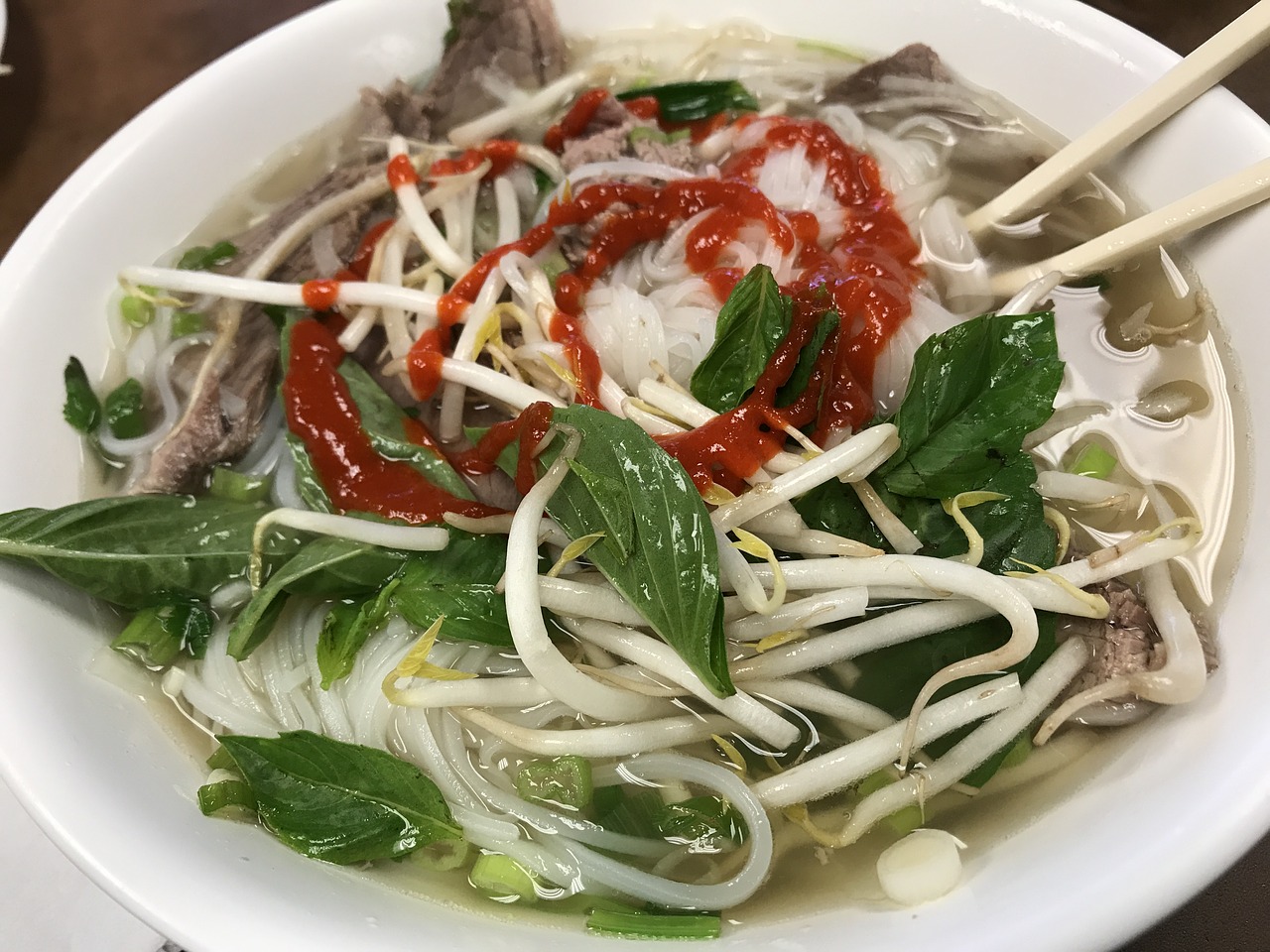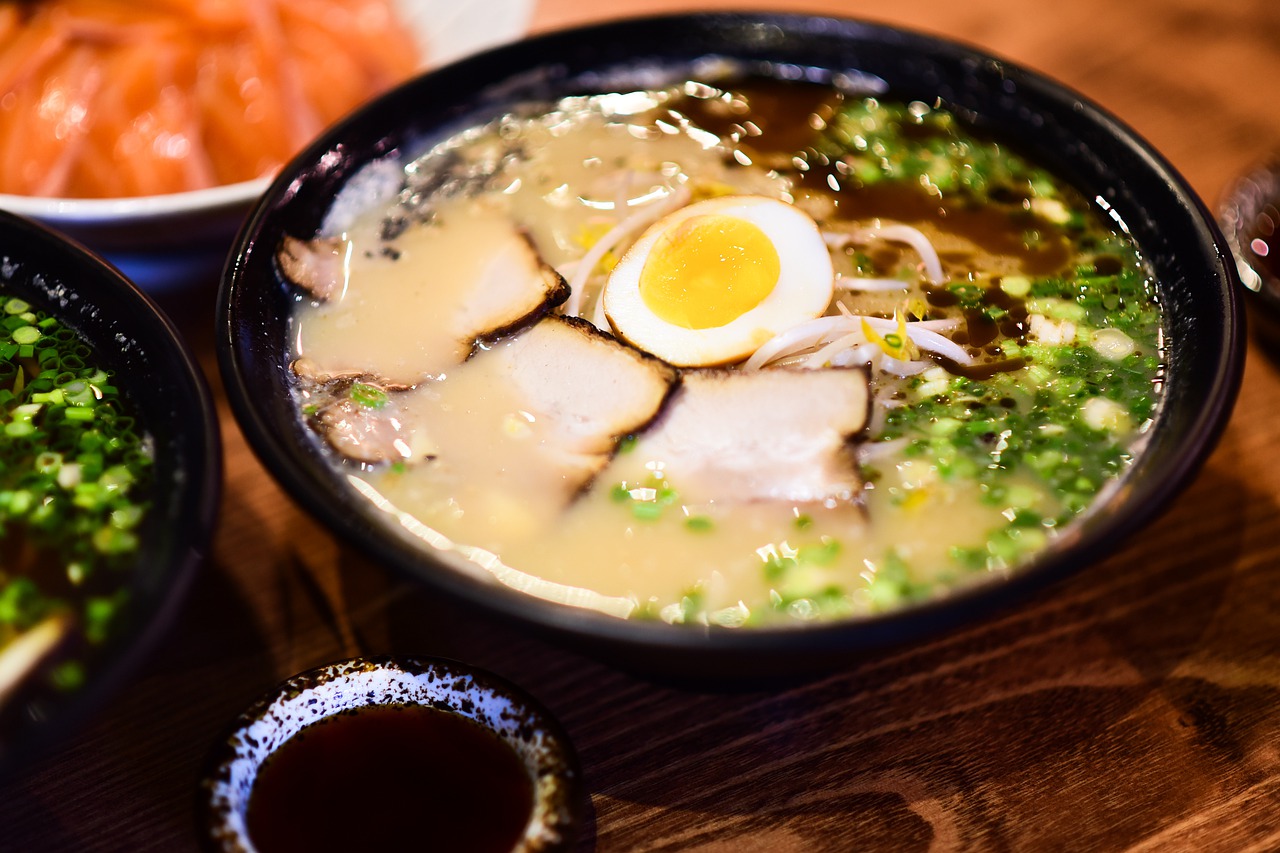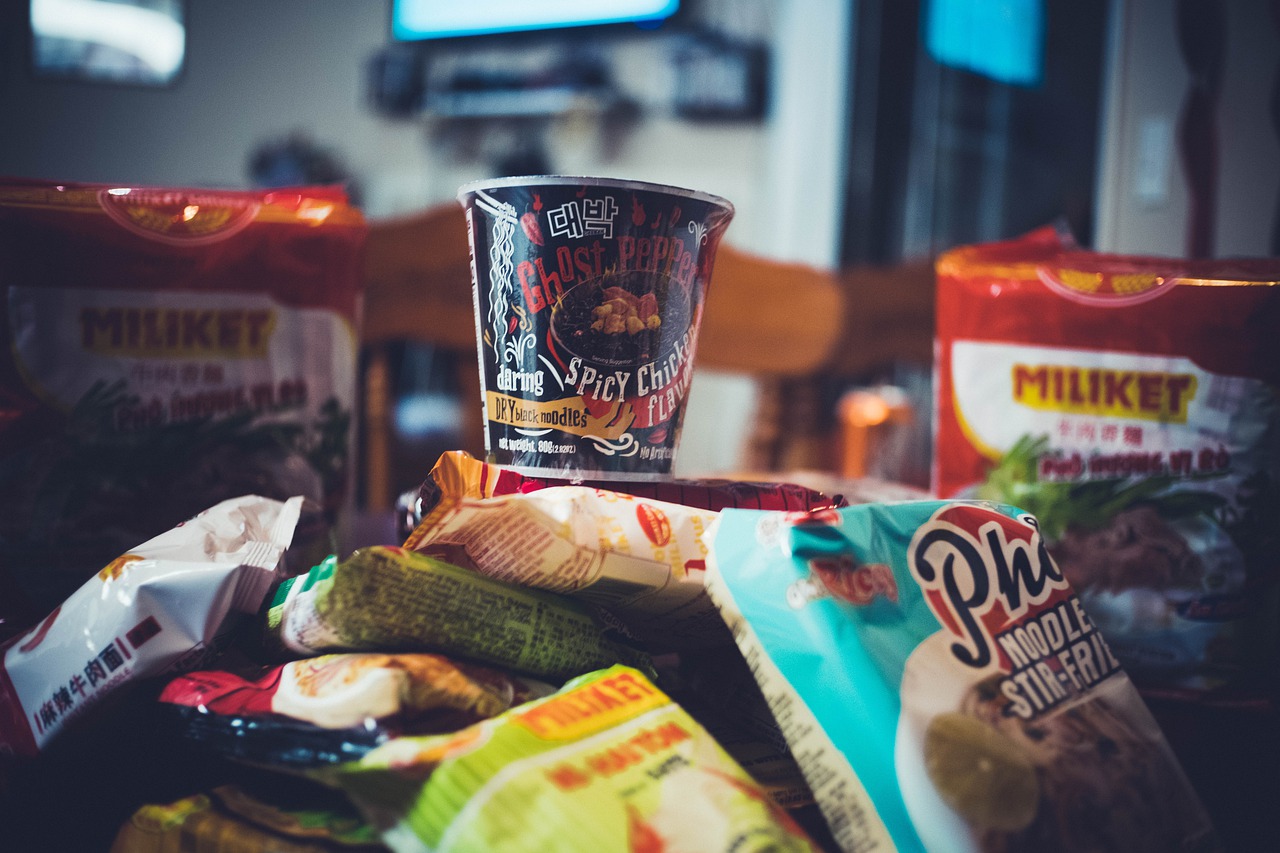Pho and ramen are both common soup noodle dishes popular in different parts of Asia (as well as around the world). I’m personally a huge fan of both but I’ve met people who didn’t know what pho was or that ramen isn’t just instant noodles in a bag or cup. I also didn’t know they had a shared historical connection.
I wouldn’t have even suspected a shared origin if I hadn’t been exploring Google trends blowing off some steam. There was a comparison between the two terms in terms of searches. I got a little curious and stumbled onto a common link between these two types of noodle dishes. It also turns out they aren’t near as old as I would have thought either.
Like any historical look into the origins of a food, there’s going to some controversy about the exact origins one way or another, but pho and ramen most likely have a shared connection. Both are derived from Chinese foods which were converted into something locals wanted and constrained by local ingredients which became something entirely new and unique. Let’s go over what pho is, its history, then we’ll do the same with ramen before discussing the mixed history.
A Description of Pho

Pho (or more properly phở in general or phở bò for the beef version that defines the dish most people refer to as “pho”) is a soup-based rice noodle dish from Vietnam. It’s basically cooked rice noodles and some kind of meat (traditionally beef for the most commonly known version) which has broth poured over it. A lot of places will throw in some thinly sliced onions or at least have them on the side. Chopped green onions and other herbs (e.g. cilantro) and spices may be added.
It’s commonly (though not always) served with a plate of bean sprouts, Thai basil (or similar), chopped chilis (or jalapenos down south in the US), and some lime. You might also get a mix of some other green leafy vegetables, other add-ons, or herbs like cilantro and chives. There’s usually several different types of sauces such as sriracha, hoisin sauce, or even an oil based chili sauce (like 油泼辣子, usually with garlic or similar though) on the table.
The dish is light and is considered a breakfast food in Vietnam. There’s also a difference in the northern and southern varieties, but there have been cultural difference between segments of the country since the colonial days of French Indochina. The broth is light and aims to be subtle and refreshing. It highlights the ingredients rather than overwhelms them in every version I’ve had. Some people take this as bland, but it is anything but with the right cook or chef.
The broth is traditionally made from beef bones (or similar), ginger, onions, and aromatic spices. These spices may include things such as anise, cloves, cinnamon, coriander, fennel, cardamom, etc. Rock sugar, salt, and fish sauce are often added to enhance the flavor. Basically, bones are quickly boiled, scum is dumped, the bones are rinsed, aromatics are toasted, and then then everything else is thrown in and boiled to create a light, clear broth with a complex flavor profile ranging from delicate to rich.
Further Reading on Pho
Recipes:
A great simple recipe for beef pho.
A great, authentic recipe.
A recipe with more focus on the accompanying herbs.
Variations:
An article about the differences between northern and southern pho.
An article about some of the other varieties of pho.
History of Pho
The modern form of pho we know likely originated in the early 1900’s (1900-1907 roughly) in northern Vietnam’s Nam Định province. There are other accounts which put it earlier, but the modern form does take some from the French colonial occupation of Vietnam (primarily the use of beef).
Even the origin of the word is a bit contentious chocking it up to either French or Cantonese. Some sources argue the word “pho” is derived from the French for pot-au-feu (the feu for fire becoming the source for pho). There’s also an argument for it being from Cantonese that explains phở is an abbreviation of lục phở which is a corruption of ngưu nhục phấn from Cantonese (牛肉粉). The soup was also said to be commonly sold by Chinese street vendors. Some sources even put it up to a mixture of the two cultural influences combined with the native Vietnamese influence which makes an even more complex dish.
Pho was traditionally a northern affair, but the Vietnam War displaced a large number of people down south. This allowed pho to evolve and change and lead to a difference between the northern and southern styles of pho. A lot of pho types common in the US pull from both styles in my experience.
Refugees from the fallout of the Vietnam War brought pho to many places. By the 90’s, it had reached the mainstream in the United States. Pho became a cultural thing where Vietnamese immigrants settled and reached a certain share of the population.
The current pho you see in most restaurants that includes a veggie plate is an adaptation of the southern style. Some places may serve a more northern style bowl, but include the plate due to local expectations. Unlike Chinese food or similar, pho and most Vietnamese food managed to escape Americanization in the US.
A Description of Ramen

Ramen is a savory Japanese noodle dish with wheat or egg noodles in a rich, fragrant soup. You usually get a rich broth with some kind of added flavorings, with noodles, some kind of meat, an egg (hard-boiled or close), some vegetables, and a mix of many different other ingredients depending on the restaurant. While pho has a more rigid expectation for what you get, ramen has seemingly countless varieties even if they have the same names.
Ramen tends to be defined by what enhances the base rather than the base itself. So, if you get soy sauce ramen (shoyu), it’s usually the restaurant’s (or chef’s) base broth with soy sauce and similar added in. There are flavors like miso, spicy ramen broths, and similar. Unlike many dishes, ramen is defined by the basics of what’s in it rather than a recipe.
You get noodles in soup with or without additional ingredients. More often than not, you get a meat or fish broth, with some kind of savory, heavy sauce like miso or soy sauce, then with toppings like sliced pork, eggs, vegetables, nori (seaweed), etc. with Chinese style wheat noodles. Most people expect a bit of meat (usually pork), an egg, and some kind of vegetables (pickled or fresh). The soup itself will depend on the region, the chef, and the gimmick even. I’ve experienced restaurants where the same recipe feels like a new dive into culinary evolution which each change of chef or even cook. The minute details become the definitive characteristics differentiating some dishes from others which were sold with the same principles.
Instant Ramen
Ramen is also famous for instant noodles. I grew up (and sometimes still subsist) on instant ramen and similar noodles. It’s not exactly the healthiest diet, but it definitely keeps you full and going with a little tweaking. You have brands like Nissin and similar which are famous for their Cup Noodles. I’m quite partial to the stir fry line.
Instant ramen brought about a cheap, easy foundation to creating a full meal. You can cook instant ramen on its own and have a decent, albeit overly salty meal, or you can modify the meal like a soup-noodle-based Hamburger Helper. Basically, you furnish the popular vegetables, meat, or whatever other ingredients and a carb-heavy, problematic part of a good meal is taken care of. We used ramen when it was cheaper to make so many things which required noodles when we had limited real estate for making food.
To top it all off, you have so many different flavors. A chicken ramen with its focus on turmeric enriched soup can be used to support some kind of curry dish or to simplify it. Beef ramen and some spices became a really lacking pho when it wasn’t available near me.
The flavor packets can also be tossed out if you need some chewier noodles for what you’re making but don’t have the time or access for certain types of noodles. 3 minutes to cook the noodles and you’re ready to move on. Fry up some cheap meat and onions, pour in some spaghetti sauce, and toss in some ramen and you have a comfort food in minutes with even a single burner and nothing else. Instant ramen can be the meal itself, or the start to many, many recipes which use longer noodles. It just takes some creativity.
Further Reading on Ramen
Recipes:
Simple chicken ramen
Simple, easy ramen
Shoyu ramen
Ways to upgrade packaged, instant noodles
Regions and Types:
The fact instant noodles caught on combined with the many regional styles of Japanese cuisine mean that there are near endless versions. There are different broth types, but there are also different variations of the same things.
Here are some of the common types of broth bases.
This article goes over the regional variations.
Some of the best instant ramen that’s easily available:
History of Ramen

Ramen has a long, rich history before becoming associated with instant noodles. Ramen derives from the Chinese for 拉面 (lāmiàn), and is basically a derivative of a Chinese wheat noodle dish with a Japanese twist. Lamian is known from as far back as the early 1500’s and involves making a dough (hitting, rolling, and working the ingredients) and pulling it (拉 in Chinese) into thinner strands which become the actual noodles. I lived in an area famous for the dish and the work which goes in is incredible.
Ramen itself was first served in Japan (in a distinct form, like pho, the history is murky) in 1910, being served in a restaurant called Rai-Rai Ken in Tokyo. The restaurant employed Chinese chefs from Yokohoma’s Chinatown and they originally popularized it as shina soba (Chinese soba). Ramen caught on with blue-collar workers due to being cheap and filling. The history gets a bit darker around the start of World War 2 for Japan and ramen became associated with the conquering of China.
This popularity of the first wave was short-lived since there were food shortages after World War 2. The instant variety of ramen came about in 1958 thanks to Momofuku Ando. The first version was a chicken instant ramen which was made by steaming the noodles, then dehydrating them in oil so that they just needed to effectively be rehydrated to eat. Nissin Cup Noodles was founded by Momofuku Ando and became a cultural phenomenon.
The Historical Dish of Ramen
The noodles are traditionally made with wheat flour, water, salt, and kansui (an alkaline mineral water, believed to originate from Inner Mongolia), though some recipes just add some baking soda or similar instead. Eggs or kansui make the noodles hold up more and make them suitable for putting in soups.
The broth is made from boiled bones, usually those of poultry (specifically chicken) or pork. Some will add bonito, others add miso, etc. Ramen has many variants and many acceptable base ingredients to fit tradition. The original had Chinese style pork which would imply a pork stock (i.e. bones on hand and Occam’s razor barring a better source).
There’s a 1910 brand which pushes has made it harder to search. You get marketing cutting into the classic. I really don’t know, but pork bone is reasonable as that fits the source and some of the descriptions. This was a common source of meat and stock at the time. There may have been variants, but they aren’t well enough recorded I could find them on a cursory search.
A Shared Connection
Both pho and ramen are soup noodles with a history tracing from China but enhanced by local tastes and local ingredients. Pho is more consistent between restaurants and regions, but the subtle variations make all of the difference between different bowls. You get largely the same base (aside from some of the other types which reference the base broth). A lot of the variations are left up to individual diners with differing options available depending on what is common.
Ramen has a common base with Chinese lamian, but the implementation is heavily different with each version or offering. You get noodles in a soup which varies with what’s available locally and what ingredients work in an area. Japan has islands with differing environments, while Vietnam is more similar from north to south (but arguably with a bottleneck). You get differences, but each differentiation makes for a different meal with the same pedigree.
Both are savory soup-based noodle dishes made to fill people up. Pho is lighter, but still has a rich, distinguishing taste that makes it every bit as enticing as ramen but with different reasons. Ramen is heavier and (arguably) heartier with the ingredients melding into a consistent experience where you can’t definitively define it, but you can definitively say you experienced it. Each have their own appeal and their own uniqueness that makes them amazing in their own ways. They share a historical connection with China, but each iteration and difference keeps them true to their roots while also highlighting the differences making two completely different dishes with different philosophies and implementations.
I love both, but for different reasons. One is the faithful spouse, the other is the fun parental figure. Each has an essential role but a differing appearance. It gets confusing when defining what element belongs to what figure. There is a certain excitement and adventure with one, but careful exploration with the other. They’re part of the same family, but you get wholly different experiences.
Image by Steve Buissinne from Pixabay




